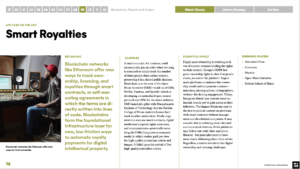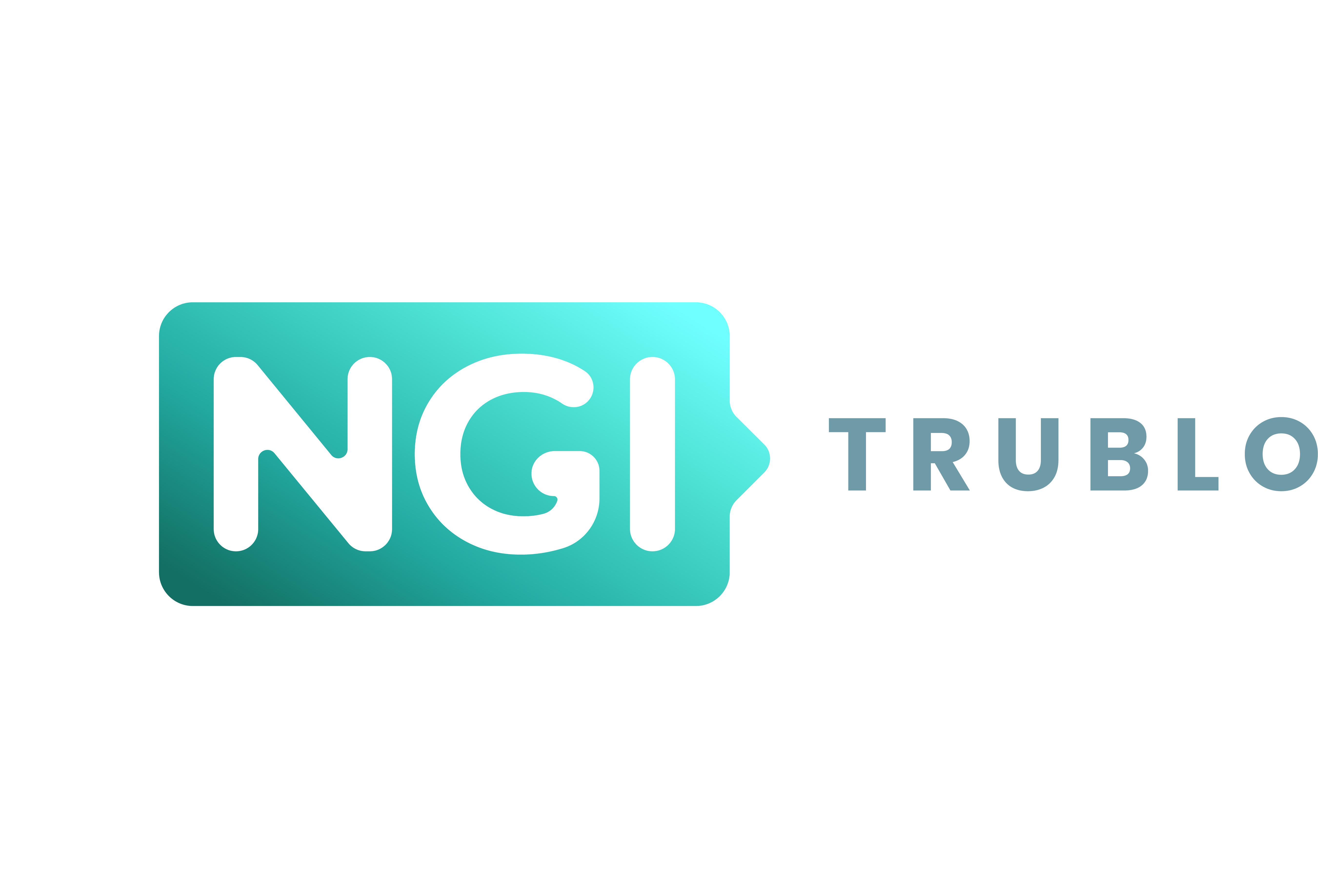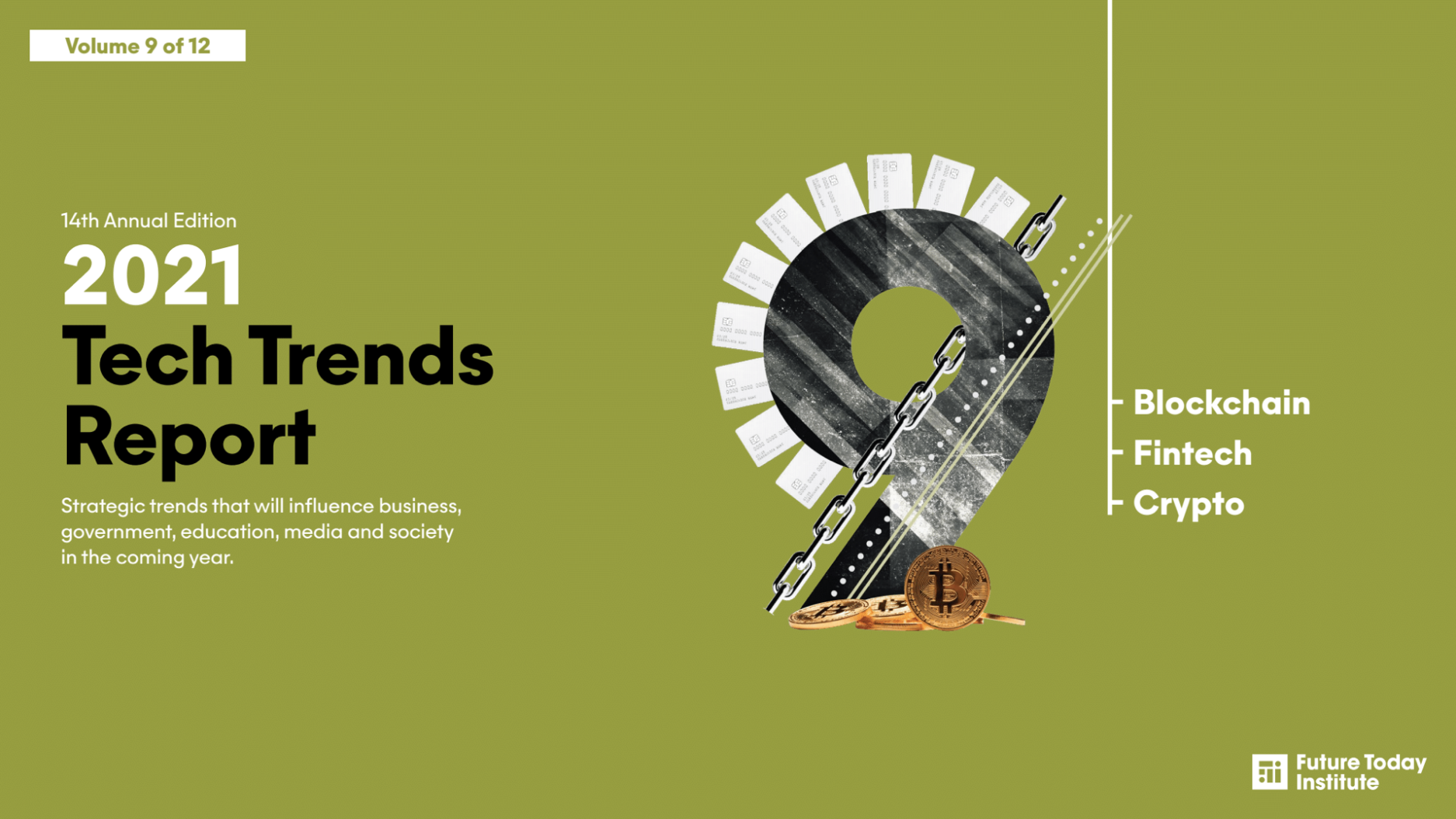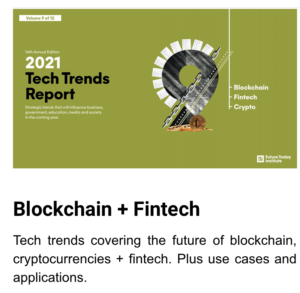Background: For years now Futurist Amy Webb and her team at the Future Today Institute in New York City publish insightful trend reports. The researchers dig through mountains of material, the goal is to find out how new developments will affect business and society. By now the yearly Tech Trends report has become a highly important source for many organisations around the world. The findings help to develop individual strategies and start to innovate.
- How is the report organised? The entire Tech Trend report delves into more than 500 trends. For the 2021 edition, this 14th annual Tech Trend report is split up into 12 smaller reports, based on topics. One of those covers blockchain, which is what we care about here.
Key elements of the 2021 Tech Trends Report

Six indicators for each trend
To make the importance of each trend clearer, the report provides six indicators for each.These indicators are very helpful to understand whether a trend is important right now or over a longer period. Below are the six indicators used in the Tech Trend Report.
- Years on the list: Some trends show up for the first time, others have been reported upon for several years. It must be noted that some trends take more than a decade to fully evolve. Others fade away when expected technologies are not evolving or when buyers are not interested as expected.
- Key insight: A brief description of the trend, in simple words. This alone is helpful, simply to learn about many trends which are new and relevant.
- Examples: Providing examples of the trend at work, by naming projects and companies.
- Disruptive impact: What the trend might mean for business, government or society
- Emerging players: “Individuals, research teams, startups or other organizations emerging” around the specific trend
- Action scale: As a conclusion, the Tech Trend report provides recommended actions. These are ranging from “Watch closely” to “Informs strategy” to “Act now”. The latest stage is reached when uncertainty is low, there is data supporting the trend evolution.
Key trends for blockchain, fintech and crypto
- The trends report is not just cheerleading further growths of tech. While some developments are seen as solutions to problems, the researchers warn about pessimistic scenarios for some trends, for example, the idea of “Human IPOs” (where people auction off their time, decisions).
- The TruBlo take: What we found interesting: There are many opportunities for far-ranging impact for society, for example by making remittances simpler, easier and cheaper. The social aspects, over time, should be as important as the speculative, purely financial aspects of blockchain and crypto. By being of value for many and being reliable the chances for blockchain technology to fulfil expectations and promises is much more likely than simply using it for casino-style speculation.
General observations
The report starts with a summary of recent observations around blockchain and new finance platforms. These are not trends, but current conditions and characteristics of the blockchain field. The key observations, as reported by The Future Today Institute, are:
- Existing, large crypto holdings enable investments for innovation.
- Decentralised financial instruments will be adopted by enterprises
- Four dozen countries are piloting digital fiat sovereign currencies
- Blockchain is adopted for supply chain management, often for environmental purposes
- Big demand for impartial and secure financial systems for fast (and low-cost) transactions
- Smart contracts could remove intermediaries
- Fractional ownership might evolve, based on the option to sell and trade tiny parts of an asset with crypto money fractions
Blockchain trends for 2021
Trend 1: Central Bank-Backed Digital Currencies (CBDCs)
There are big forces at work here. Should central banks enable digital currency, the whole cryptosystem would get a big boost. There are many positive aspects here: Payments could be executed faster, with fewer costs. What authorities try to avoid at all costs are big mistakes, such as sudden security problems, money theft or other illicit activity.
Examples (from Tech Trends Report) to better understand this trend: “In 2018, the Marshall Islands created a new digital currency called the Sovereign (SOV), which is now legal tender in the Micronesian nation. Singapore’s central bank created a digital currency backed by the Singapore dollar that runs on the Ethereum blockchain. Canada’s central bank has been researching the issuing of digital currency. China is the undisputed leader in CBDCs, successfully executing a large-scale pilot of more than 4 million digital yuan transactions from April to December 2020. An international coalition of central banks, including the Bank of Canada, Bank of England, Bank of Japan, European Central Bank, and U.S. Federal Reserve, issued a report in October 2020 outlining key principles for CBDCs.
Trend 2: Stablecoins
A stablecoin is a digital currency, but with the value connected (“pegged”) to a real-world currency. Quote from the report: “Stablecoins—specifically those pegged to the U.S. dollar—open up a universal means of exchange across the globe without traditional financial hurdles. People can now store savings in a stable asset rather than a local currency suffer- ing from inflation, and stablecoins offer faster, more affordable remittances.”
Trend 3: Social payments
The title of this trend initially a little misleading. It’s not so much about social, but about shifting payment features to social media platforms – to then be able to offer payment services like banks and credit cards. The trend is already huge. It will likely accelerate a global trend to move from cash money to digital tools, such as payment apps on mobile phones.
- Examples (quoted from Tech Trend Report): “In 2009, Venmo became the first social payment app, requiring users to caption their transactions and offering the option to share transactions publicly. Owned by PayPal, it now has 300 million users, and social payments is a serious financial service sector. China’s Alipay gives its 870 million users access to wealth management services, loan applications, and credit scores—and issued half a billion dollars in Chinese loans in 2020. Face- book’s new WhatsApp Pay has 400 million users in India. Apple and Goldman Sachs created a credit card for iPhones and Apple Watches. Uber Money will build a bank for its drivers. Amazon is exploring a checking account service to go with its existing branded credit card. This year, Google will launch GooglePlex, a banking app integrated with Google Pay—creating a single app to pay businesses and peers, manage savings, and conceivably even apply for loans.”
Trend 4: Content Provenance and Permanent Archiving
One use case for blockchain which has not been mentioned that often: Content verification, content provenance (who published something and when) and permanent archiving (as a means against censorship).
Quote: “Blockchains can be used as a universal index of content authorship and edits. This is a powerful tool to authenticate content and to combat censorship and misinformation.
Trend 5: Automated Credit risk modelling
This trend does not rely on blockchain, but on the introduction of AI (Artificial Intelligence) to credit risk calculation. The danger here is that a system analyzed by machines might lead to unintended, but nevertheless, the extremely harmful bias of a system against certain lender groups in society e.g. marginalised communities.
- DISRUPTIVE IMPACT: “In many cases, using AI in credit modelling has increased bias against marginalized groups. However, automated processes based on behaviour, and not demographics, could result in more just and equitable outcomes.”
Trend 6: Decentralized Exchanges and Automated Market Makers
Examples (from Tech Trend Report): “Centralized markets like the New York Stock Exchange or Nasdaq maintain fair, consistent, and transparent processes for publishing prices and orders, where market makers provide liquidity with both buy and sell positions. In cryptocurrencies and fully electronic markets, algorithms typically price assets, rather than traditional market books. Ethereum-based decentralized exchange Uniswap surpassed $50 billion in lifetime volume, despite concerns about liquidity and volume from darknet markets. Just months after its 2020 start, Curve.fi hit more than $47 billion in volume and became a decentralized finance leader. Total trading volume for these exchanged ballooned to $6 billion as of the first half of last year, up from $2.5 billion in 2018 and 2019.”
Trend 7: Web 3.0
This trend is about new options, extended capabilities of browsers, including financial or near-financial transactions. From the report: “Web 3.0 allows for web browsers and mobile applications to perform more complex processes and enable entirely new kinds of transactions.”
- Examples: “Collaboration and decentralized creation are accelerated in Web 3.0—often referred to as the semantic web. Advanced techniques in data mining, natural language processing, and text analytics will make gathering and understanding unstructured data much easier. Plus, artificial intelligence and machine learning allow machines to collaborate directly with one another and, eventually, teach one another. In media, Otoy is cutting the costs of 3D visual effects production with a decentralized, distributed network of partners that can chip in spare processing power with a digital token known as RNDR. The InterPlanetary File System, a peer-to-peer hypermedia protocol, facilitates decentralized file sharing and cloud computing. Companies like Blockstack and Cosmos are building networking products that will unlock a new generation of applications and services.”
Trend 8: Smart Royalties
- Quote from the report: Blockchain networks like Ethereum offer new ways to track ownership, licensing, and royalties through smart contracts or self-executing agreements in which the terms are directly written into lines of code.
 Blockchains form the foundational infrastructure layer for new, low-friction ways to automate royalty payments for digital intellectual property. A smart contract, for instance, could automatically pay an artist when her song is streamed or simply track the number of times people share online content, preserving it in a shared public database.
Blockchains form the foundational infrastructure layer for new, low-friction ways to automate royalty payments for digital intellectual property. A smart contract, for instance, could automatically pay an artist when her song is streamed or simply track the number of times people share online content, preserving it in a shared public database.- Example: Blockchain is at the core of the Open Music Initiative (OMI)—made up of IBM, Netflix, Pandora, and Spotify—which is developing a standardized open-source protocol and APIs for the music industry. OMI launched a pilot with the Massachusetts Institute of Technology that lets Berklee College of Music students license their work to other universities.
Trend 9: Distributed Computing for a Cause
For example: “…the Golem network, uses Ethereum blockchain and lets people rent out idle computing resources like storage, processing power, or band- width to render computer-generated images, conduct DNA analysis, and tackle machine learning tasks.”

Screenshot of Golem Network Homepage
Trend 10: Fractional Ownership
- Quote from the report: “Fractional ownership, commonly associated with time-shares, allows unrelated parties to divide costs and risks in order to collectively own an asset. Now that the concept is being applied to blockchain and digital platforms, it can unlock new ways to purchase and own assets, whether they’re in fine art, stocks, or other markets.”
This trend shows how far-reaching changes in financial systems can be. Co-sharing has potential. But one must be very careful to not allow scams from the past to be repeated in the digital world.
Trend 11: Self-Funding Digital Infrastructure
- Quote: “Although much of the internet relies on free open-source software, people are more inclined to use it than maintain it— which is difficult and often leads to burn-out of key contributors. Gitcoin, which caters primarily to the Ethereum blockchain community, created a marketplace of bounties for open-source developers who want to contribute to projects and earn income for their work. Since 2017, Gitcoin has facilitated $10.6 million open-source software projects. Other crypto projects, such as Zcash, earmark a portion of each “block reward”—the number of new coins that enter the circulation as the crypto is mined—to go toward community development.”
Trend 12: Non-fungible tokens and Digital Collectibles
Non-fungible tokens are a variety of crypto assets. In essence, they can not be split up. Instead, they are a link or identifier for a specific, unique asset – such as a work of art or a video or a song. On exchanges, it is possible to buy this item and then own it exclusively, though only in digital form.
- NBA Top Shot, the recent auction of Beeples work via Christie’s are good examples. “As more aspects of our lives shift online, demand for digital status symbols and personal expression will increase.” Blockchains enable digital tokens that are provably unique and scarce. As a result, digital collectables are now a growing feature of eSports, online gaming, and social networks. These unique tokens have a variety of applications—from personal expression to commerce to investing.
Scenarios
Inserted into the blockchain trend report are three scenarios. These are larger possible evolutions, such as agreements on new global exchanges. The most interesting, in our opinion, is a scenario called “A new Bretton Woods”. The scenario could evolve around the concept of a “bancor”, a supranational currency for global trade. This would mean that not one country has a dominance in international trade or profits from the demand for its currency.
There is a negative scenario in the report, too. It is about a very new trend on some new social networks, where people (celebrities, influencer) can “go public”. This would mean that others can invest in them, with money or engagement. This scenario brings up a number of red flags because it might easily cross borders in a very negative way.
Key take-aways
Here are the key insights from the blockchain report:
- Strategy: Innovative use cases for blockchain abound, but the complexity of the ecosystem remains a hurdle for most companies
- Innovation: Companies interested in blockchain struggle to find meaningful use cases. Chief innovation officers can champion companywide ideation to identify value, brainstorm new use cases, test desirability and feasibility, create a proof of concepts with paper or functional prototypes, and launch new pilots— with systems to collect data, test, and evaluate applications. Within many organizations, blockchain enthusiasts are hiding in plain sight, ready to contribute to new initiatives.
- R&D: More work is needed: re-searching bitcoin’s long-term economic security and addressing the protocol risks of crypto-currencies and deep code reviews.
- Risks: In the longer term, as smart contracts and blockchain peer-to-peer frameworks gain acceptance, business models must transform. Blockchain will reduce operational costs and increase efficiencies. Human-based trust models will transition to algorithmic ones, potentially exposing companies to new risks.
Questions to ask
In general, any organisation should at least watch what is going on in blockchain and the financial markets. The trend is strong. It is partially good, partially dangerous that most of the markets are only used by small “insider communities”. The general public, so far, has not found wide-ranging use cases for crypto. But that might change, although only after some crashes and large scale scams. Once the systems reach a certain maturity later, the questions to ask are:
- How will blockchain drive the efficiency of business practices?
- Is there adequate planning for the longer term? And which assumptions must hold true for the current strategy to succeed?
- Which parts of an organizations business are vulnerable to disruption by blockchain?



0 Comments